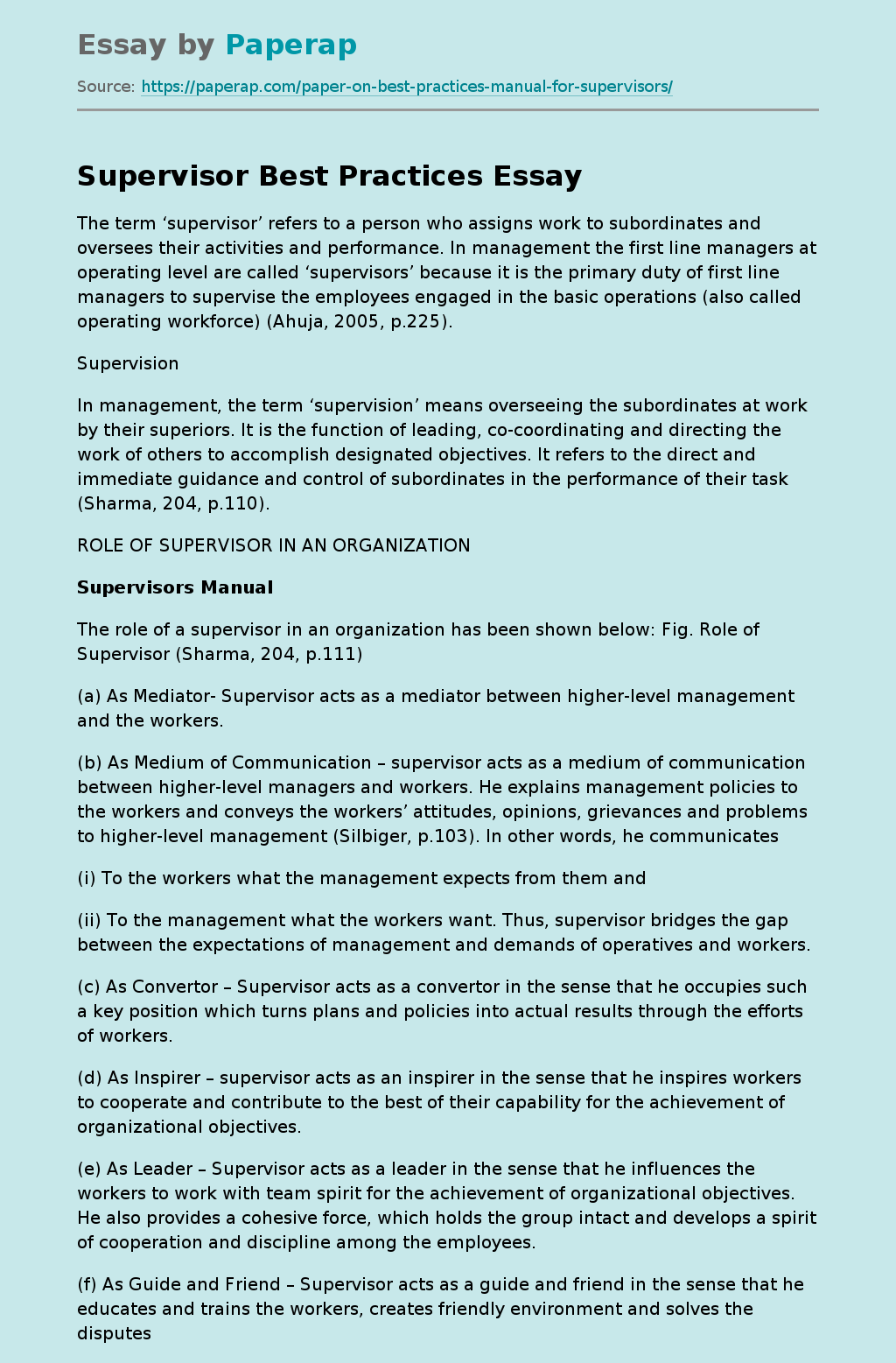Supervisor Best Practices
The term ‘supervisor’ refers to a person who assigns work to subordinates and oversees their activities and performance. In management the first line managers at operating level are called ‘supervisors’ because it is the primary duty of first line managers to supervise the employees engaged in the basic operations (also called operating workforce) (Ahuja, 2005, p.225).
Supervision
In management, the term ‘supervision’ means overseeing the subordinates at work by their superiors. It is the function of leading, co-coordinating and directing the work of others to accomplish designated objectives.
It refers to the direct and immediate guidance and control of subordinates in the performance of their task (Sharma, 204, p.110).
ROLE OF SUPERVISOR IN AN ORGANIZATION
Supervisors Manual
The role of a supervisor in an organization has been shown below: Fig. Role of Supervisor (Sharma, 204, p.111)
(a) As Mediator- Supervisor acts as a mediator between higher-level management and the workers.
(b) As Medium of Communication – supervisor acts as a medium of communication between higher-level managers and workers.
He explains management policies to the workers and conveys the workers’ attitudes, opinions, grievances and problems to higher-level management (Silbiger, p.103). In other words, he communicates
(i) To the workers what the management expects from them and
(ii) To the management what the workers want. Thus, supervisor bridges the gap between the expectations of management and demands of operatives and workers.
(c) As Convertor – Supervisor acts as a convertor in the sense that he occupies such a key position which turns plans and policies into actual results through the efforts of workers.
(d) As Inspirer – supervisor acts as an inspirer in the sense that he inspires workers to cooperate and contribute to the best of their capability for the achievement of organizational objectives.
(e) As Leader – Supervisor acts as a leader in the sense that he influences the workers to work with team spirit for the achievement of organizational objectives. He also provides a cohesive force, which holds the group intact and develops a spirit of cooperation and discipline among the employees.
(f) As Guide and Friend – Supervisor acts as a guide and friend in the sense that he educates and trains the workers, creates friendly environment and solves the disputes of the workers. In this way, he ensures team spirit, co-operation and discipline amongst the members (Sharma, 2004, p.115)
Thus, the Supervisor is expected to secure not only the efficiency of operations but also the team spirit, co-operation and discipline among the employees.
DETERMINING EFFECTIVE ORIENTATION AND TRAINING METHODS
• Training and Development
Training is usually taken to mean providing employees with knowledge or specific job skills to satisfy immediate job or organizational needs. This could range from assembly workers learning new techniques to enable them to increase output, to managers learning how to better manage their time. (Yvonne, 1999, p.120)
Development usually refers to preparing employees for longer-term opportunities. It encompasses both personal and organizational needs and has a more general focus.
Supervisor provides training and development in an organization usually following four steps:
(a) Identifying employees training and development needs; (b) Developing a training plan for each individual; (c) Selecting or designing or conducting training activities; (d) Evaluating the results.
Supervisor identifies training needs in an organization by following three main methods:
i. New employees – training is required immediately in order for the employees to perform the work satisfactorily. ii. Performance appraisals – an employee’s output may indicate that further training is required, or he or she may request training in a specific area. iii. Future needs – employees are trained in anticipation of future needs (often involving the use of technology).
Care must be taken by the supervisor to ensure that training will solve a specific problem. Sometimes other options may be more effective, such as: changing the job, or some aspect of it; changing the salary or wage structure; or introducing flexible working hours Sometimes various types of training activity are used simply to motivate employees. (Yvonne,1999, p.125)
Supervisor in some organizations develop formal training plans for their employees. Such training plans tend to be more specific for people in the lower levels of the organization, and more general for people at higher levels. Sometimes such training is part of the career development for certain individuals.
• Improving The Work Environment
People whose work is highly specialized, repetitive and routine may become dissatisfied with their job. This dissatisfaction often shows itself by reduced output, increased absenteeism and high staff turnover. This very quickly reduces effectiveness of a work area, and influences the effectiveness of the whole organization. A number of approaches have been developed to try to overcome this problem.
Supervisor Best Practices. (2019, Dec 05). Retrieved from https://paperap.com/paper-on-best-practices-manual-for-supervisors/

